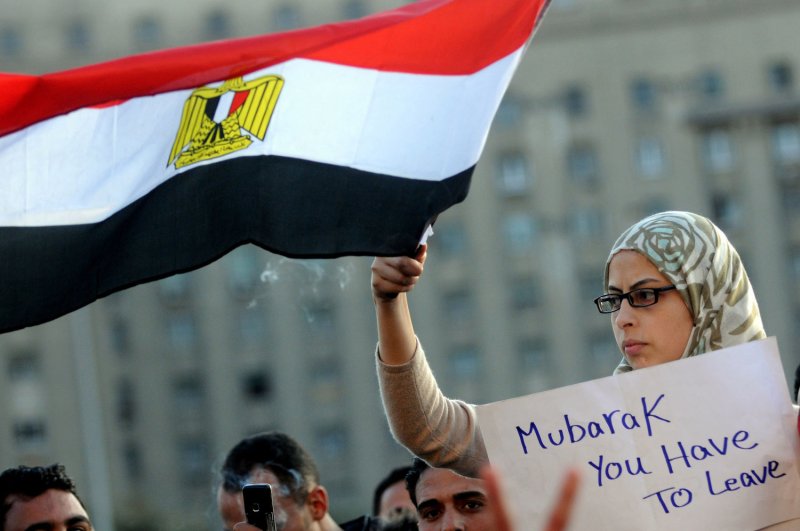Egyptian demonstrators protest in Cairo's main square square during the biggest anti-government protests in three decades in a bid to topple the government President Hosni Mubarak in Cairo, Egypt on January 31, 2011. UPI |
License Photo
WASHINGTON, Feb. 1 (UPI) -- Last Wednesday, the Federal Reserve of the United States released a mixed-bag statement of the Federal Open Market Committee's assessment of the domestic economy.
Among the happier moments was that household and business spending is on the rise -- and yet, the FOMC noted, "longer-term inflation expectations have remained stable, and measures of underlying inflation have been trending downward." In fact, the statement continued, "measures of underlying inflation are somewhat low, relative to levels that the committee judges to be consistent, over the long run with its dual mandate."
Half a world away, meanwhile, Egypt was erupting in flames as its people took to the streets decrying their country's sham democracy, rampant corruption, high unemployment and skyrocketing food prices. Protesters burned cars and hurled insults; police threw tear gas and swung batons; and the three decades of rule by strongman Hosni Mubarak came perilously close to breaking.
Mubarak, of course, is much to blame for Egypt's current woes and the street rallies highlight the limits of strong-arm states supported by phony economies. Officially, Egypt's economy is forecast to expand by nearly 6 percent this year -- an impressive gain for a world market still in trouble. Unemployment stands at a relatively adequate 10 percent.
Big year-on-year gains in gross domestic product and per-capita income are well and fine but not when economies are one-trick ponies in which astronomical fortunes are made by only a well-connected few.
As Egypt's per capita income has risen to nearly $6,000, some 40 percent of the population still lives on less than $2 a day. And while military service and bloated bureaucracies pad the employment rolls, the unemployment rate for younger workers is estimated at 30 percent or higher. Most Egyptians are condemned to a life of grinding poverty and a front-row seat to the widening disparities between the haves and have-nots.
These are griefs that Egyptians have borne for decades. To reach combustion, they needed a spark. Just as in Tunisia, the spark was skyrocketing food prices -- increasing at a brisk 17 percent annually in Egypt. That's unhealthy in any economy but particularly one in which, as estimated by the investment house Nomura, on average 50 percent of household expenditures goes toward food. (In the United States, by comparison, food costs represent 14 percent -- and falling -- of the Consumer Price Index.)
For that, Egyptians may in no small way thank the U.S. Federal Reserve and its policies of "quantitative easing" -- known by most as "printing money." Before globalization, all the new money sloshing around the U.S. economy would most likely give rise to domestic inflation. But in the interconnected world, the dollars are put to work purchasing lower-cost goods and commodities from the developed world.
Suddenly awash with dollars, prices in less-developed economies begin to rise -- a process that is exacerbated by the governments of other industrialized countries (such as the United Kingdom and Western Europe), which also print money in an effort to match the United States and keep up with global prices.
Coupled with a devastating year for drought and flooding and the voracious appetite of China, food prices -- from sugar to soy to meat -- have been soaring. The price of wheat, of which Egypt is the world's largest importer, has risen by more than 70 percent on the Chicago commodities market since its June low of $5.05.
Arguably, Egyptians now face more choice than at any time in the last 30 years. If the protesters are successful in ousting Mubarak, the leading groups hoping to succeed him couldn't be more different -- on the one hand Mohammed ElBaradei's, the former director of the International Atomic Energy Agency and Nobel Peace Prize laureate; on the other the banned Muslim Brotherhood, a fundamentalist Islamic movement.
Just as stark will be the policies Egypt's leaders choose to get a hold of their economy. Easy fixes such as price controls, subsidies and higher interest rates at best will only forestall the pain for a brief period. Larger reforms, such as economic diversification, greater opportunity and an appreciating currency, will take time but are necessary.
Egyptians may yet get the responsive government they deserve, but they can expect little help from the Fed. In its statement last Tuesday, the FOMC announced it "intends to purchase $600 billion of longer-term Treasury securities by the end of the second quarter of 2011." Time to start the printing presses again.
--
(Sam Dealey is former editor of The Washington Times and previously worked as a foreign correspondent for several publications.)
--
(United Press International's "Outside View" commentaries are written by outside contributors who specialize in a variety of important issues. The views expressed do not necessarily reflect those of United Press International. In the interests of creating an open forum, original submissions are invited.)















